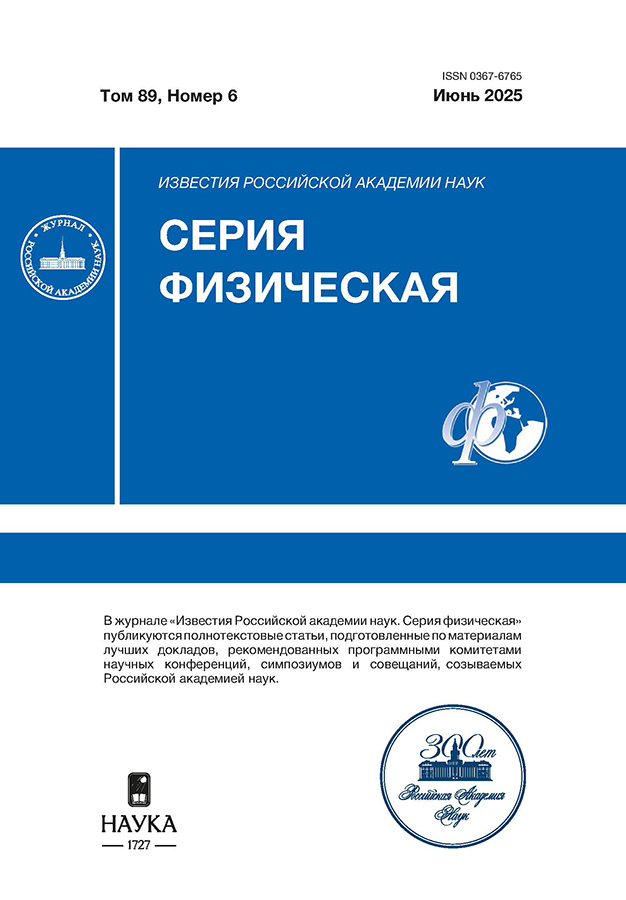The characteristics of Forbush decreases based on data from AMS-02 experiment and fluxes of solar cosmic rays on GOES-15 one
- Autores: Dorosheva D.N.1,2, Arkhangelskaja I.V.2, Borog V.V.2
-
Afiliações:
- Pushkov Institute of Terrestrial Magnetism, Ionosphere and Radio Wave Propagation of the Russian Academy of Sciences
- National Research Nuclear University MEPhI
- Edição: Volume 89, Nº 6 (2025)
- Páginas: 984-988
- Seção: Physics of Cosmic Rays
- URL: https://transsyst.ru/0367-6765/article/view/692836
- DOI: https://doi.org/10.31857/S0367676525060299
- ID: 692836
Citar
Texto integral
Resumo
An analysis of the dependence of the amplitudes of the 10 strongest preceded by Halo-type CMEs Forbush decreases in proton and helium nuclei fluxes according to AMS-02 data on the magnetic rigidity of particles showed that it is well approximated by a power function (as was shown in the PAMELA experiment) in the rigidity range from 1 to 10–12 GV. The index of this function is in the range from –0.38±0.02 to –0.68 ± 0.04 for protons and from –0.41± 0.03 to –0.79 ± 0.04 for helium nuclei. But in a wider range of rigidity values up to 20 GV, such approximation significance level is only 90–92% for protons and 90–96% for helium nuclei. Exponential functions providing 95–99% significance level both for protons and helium nuclei should be used over the entire range of rigidities. Comparison of time series for protons according to AMS-02 and GOES-15 data shows the possibility of observing SEP and SPE together with the background Forbush decreases.
Palavras-chave
Sobre autores
D. Dorosheva
Pushkov Institute of Terrestrial Magnetism, Ionosphere and Radio Wave Propagation of the Russian Academy of Sciences; National Research Nuclear University MEPhI
Email: dorosheva2000@list.ru
Moscow, Russia
I. Arkhangelskaja
National Research Nuclear University MEPhIMoscow, Russia
V. Borog
National Research Nuclear University MEPhIMoscow, Russia
Bibliografia
- Дорман Л.И. Вариант галактических космических лучей. М: Московский университет, 1975. 207 с.
- Chen F.F. Introduction to Plasma Physics and Controlled Fusion. Berlin: Springer, 2016. 497 p.
- Nakagawa Y., Nozawa S., and Shinbori A. // Earth. Planets. Space. 2019. V. 71. Art. No. 24.
- Мелкумян А.А., Белов А.В., Абунина М.А. и др. // Изв. РАН. Сер. физ. 2019. Т. 83. № 5. С. 625
- Белов А.В., Белова Е.А., Шлык Н.С. и др. // Геомагн. и аэроном. 2024. № 64. С. 289.
- https://tools.ssdc.asii.it/CosmicRays/ chargedCosmicRays.jsp?&&target=ALL& experiment=AMS-02.
- Лагойда И.А. Характеристики форбуш понижений по данным эксперимента «ПАМЕЛА». Дисс. ... канд. физ.-мат. наук. М.: МИФИ, 2022.
- Лагойда И.A., Воронов С.A., Михайлов В.В. // Физика ЭЧАД. 2019. Т. 50. № 6. С. 1077.
- Wang S., Birdi V., Consolandi C., Claudio Corti et al. // Astrophys. J. 2023. V. 950. P. 23.
- https://cdaw.gsfc.nasa.gov/CME_list/sepe.
- ftp://ftp.ngdc.noaa.gov/STP/SOLAR_DATA/ SATELLITE_ENVIRONMENT/PARTICLES/ 2012.
- https://sepserver.eu/index.php.
- https://www.ngdc.noaa.gov/stp/space-weather/ interplanetary-data/solar-proton-events/SEP%20page%20code.html.
Arquivos suplementares










